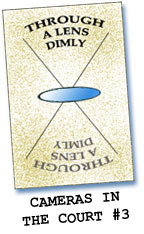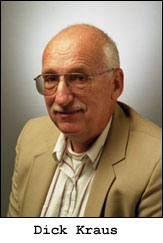CAMERAS IN THE COURT #3
by Dick Kraus
Newsday Staff Photographer (retired)
Judges and
lawyers seem blissfully unaware of the technical differences and
requirements
in camera coverage by tv and stills. One case that
I was covering, along with tv, was getting to that ho hum boring
stage where technical experts were talking about technical stuff
and it made for some pretty dull pictures. The liveliest art came
during sidebar at the judge’s bench between the prosecutor,
the lawyer and the judge. Sometimes these discussions can get pretty
animated and it offers the photographers a rare opportunity to show
the three principals in the same shot.
The defense attorney saw that this particular sidebar was being
photographed and made an objection to it. The judge upheld
the objection and forbade any more
photographing of sidebars.
At a recess, I asked the attorney why he had objected. “I don’t want
any prospective witnesses listening in to any comments that I may make in private
discussion at the judge’s bench.” he said.
“Counselor”, I replied. “Think about what you are saying. That
may be true of tv but I’m shooting stills and there is no sound.”
“Yes, I guess that’s true, but suppose someone can read lips?”
“Counselor, think carefully. We’re talking about a single still photo
here.” I said.
He pondered for a moment to let what I said sink in, and finally
agreed to ask the judge to rescind the ruling, provided the
tv sound at the
bench was
turned
off.
Another time I was sent to cover a case in Family Court. Now,
that’s a
tough one to get into under any circumstances. The case involved a mother accused
of “Munchhousen Syndrome.” That’s where the mother smothers
her child almost to the point of death and then tries to revive the child in
an attempt to play a heroic figure. In NY we have a ruling where application
for cameras in the court must be submitted 7 days prior to being allowed in court.
I reminded my editor of this and was told to make an effort to get in. He told
me that the tv news magazine “20/20” was already in and I should
try to use that as my bargaining point.
I arrived at the courtroom before the start of that day’s trial
and presented my petition. The judge summarily dismissed my papers,
not for the 7 day rule,
but simply because he felt that my presence would disrupt the
proceedings. While I was listening to this, I couldn’t help
but notice the “20/20” crew
walking all over the courtroom, filming the day’s events.
The rules specifically forbid any movement of any camera. Plus,
this crew consisted of the cameraman,
the sound man, the reporter and the producer. Now, let’s
talk about disruption. I pled my case with all of the expertise
that I could muster. The judge said
that he saw no reason to include another camera since tv was
already there. He said that I could get my pictures from tv.
I started to explain about the issue
of quality from a frame grab, but, he cut me off and ordered
me out of the court. I guess he felt that being on national tv
would
be enough. He didn’t need
any glory from the local paper.
So, I did what any right thinking still photographer would do.
I called my desk and told them to get the paper’s attorney
down here, fast. But, first he should make a call to the Chief
Judge and complain about the shabby treatment
we were accorded.
The Chief Judge made a phone call to the trial judge’s chambers and after
the lunch break, this judge announced in open court that he was being forced
to admit the still photographer.
“But”, he announced, “before I subject this court to your disruptive
presence, I want to hear how loud your cameras are. Please shoot a picture.”
I had a Nikon F4 which has a motor which can’t be disabled
in order to shoot manually. But, it does have a “quiet mode” which
slows down the film advance and is much quieter than my F3 in manual
mode. However, in the
hushed courtroom, with everybody’s attention on
me, my shutter sounded like a rifle shot going off.
“Oh no”, he shouted. “I can’t have that racket in here.
I will allow you to shoot one shot while the witness is being sworn; one shot
during testimony and one shot as the witness leaves the stand. If I hear that
camera go off more than 3 times per witness, I will hold you in contempt.”
There wasn’t anything I could do, but at least I was able to
shoot something. So, the first witness was sworn and I took my first
shot. I hesitated taking
my second shot during the witness’s testimony,
because I didn’t want
to waste my one action shot, only to have the witness
show more expression later on. I finally made my
shot, and sure enough, the witness became more animated.
I glanced at the judge and squeezed off a second
shot, fully expecting the judge
to have me led out in handcuffs. But, he was too
busy listening to the witness. So, I shot several
more photos without consequence.
When they took a break before the next witness, I
went up to the judge as he left the bench and asked
him
if we could
talk
about
the limitations
he
had
imposed upon me.
He looked a little startled. “Oh, yeah. You’re the Newsday photographer.
I didn’t hear you take any pictures. How come?”
I said, “Judge, when you asked me to make the test shot, the courtroom
was quiet and everyone’s attention was fixed on me. During the testimony,
the witness was talking; the court stenographer was clacking her machine; people
were coughing and clearing their throats; the 20/20 crew were walking all around
the courtroom filming, and no one was paying any attention to me. I made my shots
(I didn’t tell him how many) and you never heard me.”
He lifted the restrictions.
Dick Kraus
newspix@optonline.net
http://www.newsday.com
|

